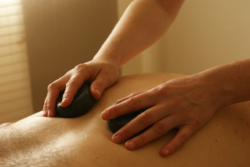Research supports massage benefits for HIV
Cochrane systematic reviews are recognised as the gold standard in evidence-based research for medicine. We have found a Cochrane systematic review which focuses on the evidence of benefits for massage for people with HIV/AIDS.
Worldwide estimates of HIV infection are in the region of 33 million, with the vast majority of those infected living in sub Saharan Africa. In 2017, it was estimated that there are 101,600 people living with HIV in the UK: 92% are believed to be diagnosed leaving 8% or just over 8000 people unaware of the infection. 98% of those diagnosed are on treatment and 97% of those being treated cannot pass on the virus.
(https://www.nat.org.uk/we-inform/HIV-statistics/UK-statistics, 2017). In the US by comparison, 2016 figures suggest around 1 million living with HIV of which 15% are unaware they have the infection. (https://www.amfar.org/about-hiv-and-aids/facts-and-stats/statistics–united-states/).
For Australia, figures published in 2016 suggest around 10% of the estimated 25,313 living with the virus are unaware of the infection. (http://www.hivmediaguide.org.au/hiv-in-australia/hiv-statistics-australia/). While HIV figures are generally decreasing around the world, in some countries, such as Turkey they grew by 465% over the 10 years between 2007 and 2017 – thought to be the biggest percentage increase being seen.

Back in 2010, The Cochrane library published a systematic review of massage therapy for HIV. A systematic review “summarises the results of available carefully designed healthcare studies (controlled trials) and provides a high level of evidence on the effectiveness of healthcare interventions. Judgments may be made about the evidence and inform recommendations for healthcare.” (Cochrane https://consumers.cochrane.org/what-systematic-review).
The Cochrane Library is generally considered the gold standard in assessing the validity of research. A charity based in the UK, with a worldwide network of researchers, they are viewed as independent and their aim is to help make health care decisions that are evidence-based. They don’t accept commercial or conflicted funding.
Cochrane lists the reported benefits of massage as “pain relief, decreased levels of depression, improved immune function, improved blood flow and blood composition, reduced edema, and increased mobility of connective tissue, muscle and the nervous system”. This would support the use of massage in chronic conditions. Some studies have suggested an increase also in immune function.
Cochrane looked at three areas where massage might help: quality of life, pain and immune system factors. Of the 12 relevant studies found, only four met the group’s requirements, eight being excluded because of their methodologies. One of the reasons that Cochrane wanted to do this review was the potential for massage to be used as a low cost intervention that could be taught to the families of patients used in developing countries where there is an acute problem and low health care budgets.
The four studies that Cochrane reviewed covered diverse ages and populations which impacted on the conclusions it could safely draw. Although the pooled data reached significance from a statistical point of view, the small size of the studies and numbers of participants limited the conclusions.
Despite this Cochrane’s conclusions was that
“Massage therapy may be recommended for PLWHA [people living with HIV/AIDS] with low to moderate evidence to support its effectiveness in improving aspects of quality of life, in early and late stages, and for different age groups. Effectiveness appears to improve when massage therapy is combined with other modalities, such as meditation and stress management. It may be that the effects of massage therapy on relaxation responses are short lived and that combining it with other methods that promote long-term stress management offer the most benefits. Clear, appropriate and globally standardised outcome measures should be implemented to gauge the effect of massage therapy given the low to moderate level of evidence. The implications for policy-makers are that services which are multi-facetted to include massage therapy should be encouraged if explicitly monitored. There is mixed evidence to support the use of massage therapy to improve immune function in PLWHA.”

What implications does this have for our practice as massage therapists?
We are often asked what is the evidence for what we do. In a nutshell, here is one of the issues identified by Cochrane: The lack of clear, appropriate and globally standardised outcome measures that can be used in order to safely draw much stronger conclusions about the impact of massage – and other therapies by extension. The question is, who is going to draw up and get these outcome measures agreed globally? Who is going to invest in the larger scale studies? It is something the whole community worldwide needs to come together on.
While infection risks for therapists in the UK are low and 97% of those treated cannot pass on the virus, it is another reminder that any open lesions in both client and practitioner should be covered, even more in countries where there is a higher percentage of people living with HIV/AIDS who are undiagnosed and untreated.
In the meantime, this is a study that is worth sharing, particularly to services that deal with HIV/AIDs patients because it comes from Cochrane and particularly worth considering combining with an addition service such as mindfulness or EFT or similar.
The full article is here:
https://www.cochranelibrary.com/cdsr/doi/10.1002/14651858.CD007502.pub2/epdf/full
Global statistics can be found here (https://www.avert.org/global-hiv-and-aids-statistics)